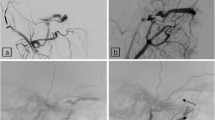Abstract
The management of carotid cavernous fistulas (CCFs) depends on their physiopathology. The classification into traumatic and spontaneous CCFs is usually considered obsolete; it is, however, the first question that we ask when a patient with a CCF is referred to us. Knowing that a fistula is traumatic immediately tells us that we have a 95% chance of treating this fistula with a detachable balloon and with preservation of the carotid blood flow (CBF). Similarly, knowing that there is no history of trauma, one may conclude that a middleaged patient with a red eye and a sixth nerve palsy probably has a spontaneous fistula of the dural type, while in the case of an older patient with this presentation one must consider the possibility of a ruptured preexisting cavernous aneurysm. Therefore, the age of the patient and the presence or absence of a history of trauma are important in the classification of CCFs.
Access this chapter
Tax calculation will be finalised at checkout
Purchases are for personal use only
Preview
Unable to display preview. Download preview PDF.
Similar content being viewed by others
References
Debrun GM, Davis KR, Nauta HJ, Heros RE, Ahn HS (1988a) Treatment of carotid cavernous fistulae or cavernous aneurysms associated with a persistent trigeminal artery: report of three cases. AJNR 9: 749–755
Debrun GM, Vinuela F, Fox AJ, Davis KR, Ahn HS (1988b) Indications for treatment and classification of 132 carotid-cavernous fistulas. Neurosurgery 22: 285–289
Debrun GM, Nauta HJ, Miller NR, Drake CG, Heros RC, Ahn HS (1989) Combining the detachable balloon technique and surgery in imaging carotid cavernous fistulae. Surg Neurol 32:3–10
Dohrmann PJ, Batjer HH, Samson D, Suss RA (1985) Recurrent subarachnoid hemorrhage complicating a traumatic carotid-cavernous fistula. Neurosurgery 17: 480–483
Dowd CF, Halbach VV, Higashida RT, Barnwell SL, Hieshima GB (1991) Occlusion of the anterior superior ophthalmic vein in carotid-cavernous fistulae acutely aggravating visual symptoms. Neuroradiology [Suppl] 33:142–143
Eggers F, Lukin R, Chambers AA, Tomsick TA, Sawaya R (1979) Iatrogenic carotid-cavernous fistula following Fogarty catheter thromboendarterectomy. Case report. J Neurosurg 51:543–545
Flandroy P, Lenelle J, Collignon J, Stevenaert A (1988) Carotid cavernous fistula associated with Fogarty catheter angioplasty. AJNR 9:1242–1242
Fuentes JM, Benezech J, Joyeux A, Vlahovitch B, Thevenet A, Vavdin F (1985) Iatrogenic carotid-cavernous fistulas, complications of carotid thrombectomy. Neurochirurgie 31:265–270
Garcia-Cervigon E, Bien S, Laurent A, Weitzner I, Jr, Biondi A, Merland JJ (1988) Treatment of a recurrent traumatic carotid-cavernous fistula: vertebro-basilar approach after surgical occlusion of the internal carotid artery. Neuroradiology 30:355–357
Halbach VV, Higashida RT, Hieshima GB, Norman D (1987a) Normal perfusion pressure breakthrough occurring during treatment of carotid and vertebral fistulas. AJNR 8:751–756
Halbach VV, Hieshima GB, Higashida RT, Reicher M (1987b) Carotid cavernous fistulae: indications for urgent treatment. AJR 149:587–593
Halbach VV, Higashida RT, Hieshima GB, Hardin CW, Yang PJ (1988) Transvenous embolization of direct carotid cavernous fistulas. AJNR 9:741–747
Hanneken AM, Miller NR, Debrun GM, Nauta HJ (1989) Treatment of carotid cavernous sinus fistulas using a detachable balloon catheter through the superior ophthalmic vein. Arch Ophthalmol 107:87–92
Higashida RT, Halbach VV, Tsai FY, Norman D, Pribram HF, Mehringer CM, Hieshima GB (1989) Interventional neurovascular treatment of traumatic carotid and vertebral artery lesions: results in 234 cases. AJR 153:577–582
Kupersmith MJ, Berenstein A, Flamm E, Ransohoff J (1986) Neuro-ophthalmologic abnormalities and intravascular therapy of traumatic carotid cavernous fistulas. Ophthalmology 93:906–912
Sekhar LN, Heros RC, Kerber CW (1979) Carotid-cavernous fistula following percutaneous retrogasserian procedures. Report of two cases. J Neurosurg 51:700–706
Serbinenko FA (1974) Balloon catheterization and occlusion of major cerebral vessels. J Neurosurg 41:125–145
Taki W, Handa H, Miyake H, Kobayashi A, Yonekawa Y, Yamamura K, Suzuki M, Ikada Y (1985) New detachable balloon technique for traumatic carotid cavernous sinus fistulae. AJNR 6:961–964
Teng MM, Guo WY, Huang CI, Wu CC, Chang T (1988) Occlusion of arteriovenous malformations of the cavernous sinus via the superior ophthalmic vein. AJNR 9:539–546
Author information
Authors and Affiliations
Editor information
Editors and Affiliations
Rights and permissions
Copyright information
© 1993 Springer-Verlag Berlin Heidelberg
About this chapter
Cite this chapter
Debrun, G.M. (1993). Endovascular Management of Carotid Cavernous Fistulas. In: Valavanis, A. (eds) Interventional Neuroradiology. Medical Radiology. Springer, Berlin, Heidelberg. https://doi.org/10.1007/978-3-642-84434-8_2
Download citation
DOI: https://doi.org/10.1007/978-3-642-84434-8_2
Publisher Name: Springer, Berlin, Heidelberg
Print ISBN: 978-3-642-84436-2
Online ISBN: 978-3-642-84434-8
eBook Packages: Springer Book Archive




